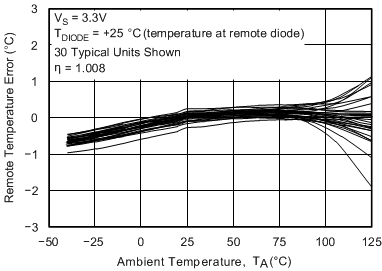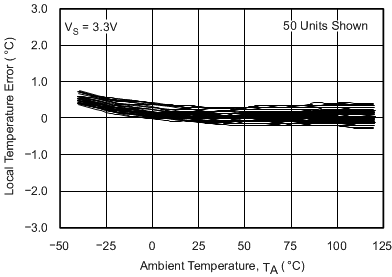SBOS383D December 2006 – December 2016 TMP411
PRODUCTION DATA.
- 1 Features
- 2 Applications
- 3 Description
- 4 Revision History
- 5 Device Comparison Table
- 6 Pin Configuration and Functions
- 7 Specifications
- 8 Typical Characteristics
-
9 Detailed Description
- 9.1 Overview
- 9.2 Functional Block Diagram
- 9.3 Feature Description
- 9.4 Device Functional Modes
- 9.5 Programming
- 9.6
Register Map
- 9.6.1 Register Information
- 9.6.2 Pointer Register
- 9.6.3 Temperature Registers
- 9.6.4 Limit Registers
- 9.6.5 Status Register
- 9.6.6 Configuration Register
- 9.6.7 Resolution Register
- 9.6.8 Conversion Rate Register
- 9.6.9 N-Factor Correction Register
- 9.6.10 Minimum and Maximum Registers
- 9.6.11 Consecutive Alert Register
- 9.6.12 THERM Hysteresis Register
- 9.6.13 Remote Temperature Offset Register
- 9.6.14 Identification Registers
- 10Application and Implementation
- 11Power Supply Recommendations
- 12Layout
- 13Device and Documentation Support
- 14Mechanical, Packaging, and Orderable Information
10 Application and Implementation
NOTE
Information in the following applications sections is not part of the TI component specification, and TI does not warrant its accuracy or completeness. TI’s customers are responsible for determining suitability of components for their purposes. Customers should validate and test their design implementation to confirm system functionality.
10.1 Application Information
The TMP411 only requires a transistor connected between the D+ and D– pins for remote temperature measurement. Tie the D+ pin to D– if the remote channel is not used and only the local temperature is measured. The SDA, ALERT and THERM pins (and SCL, if driven by an open-drain output) require pullup resistors as part of the communication bus. TI recommends using a 0.1-µF power-supply decoupling capacitor for local bypassing. Figure 11 illustrates the typical configurations for the TMP411.
10.2 Typical Application
10.2.1 Design Requirements
The TMP411 is designed to be used with discrete transistors or substrate transistors built into processor chips and ASICs. NPN or PNP transistors can be used, as long as the base-emitter junction is the remote temperature sensor. A transistor or diode connection can be used, as shown in Figure 11.
Errors in remote temperature sensor readings are the result of the ideality factor and current excitation from the TMP411 versus the manufacturer-specified operating current for a given transistor. Some manufacturers specify a high-level and low-level current for the temperature-sensing substrate transistors. The TMP411 has an ILOW value of 6 μA, and an IHIGH value of 120 μA. The TMP411 allows for different n-factor values, as shown in Table 8.
The ideality factor (n) is a measured characteristic of a remote temperature sensor diode compared to an ideal diode. The ideality factor reduces to a value of 1.008. For transistors with an ideality factor that does not match the TMP411, Equation 4 calculates the temperature error. Note that the actual temperature (°C) must be converted to Kelvin (°K) for the equation to yield the correct results.

where
- n = the ideality factor of the remote temperature sensor
- T(°C) = actual temperature
- TERR = device reading error due to n ≠ 1.008
- Degree delta is the same for °C and °K
For n = 1.004 and T(°C) = 100°C, use Equation 5:

If a discrete transistor is used as the remote temperature sensor, selecting the transistor according to the following criteria results in the best accuracy.
- Base-emitter voltage > 0.25 V at 6 µA, at the highest sensed temperature.
- Base-emitter voltage < 0.95 V at 120 µA, at the lowest sensed temperature.
- Base resistance < 100 Ω
- Tight control of VBE characteristics indicated by small variations in hFE (that is, 50 to 150).
Based on these criteria, TI recommends using two small-signal transistors, such as the 2N3904 (NPN) or 2N3906 (PNP).
10.2.2 Detailed Design Procedure
The temperature measurement accuracy of the TMP411 depends on the remote or local temperature sensor being at the same temperature as the monitored system point. If the temperature sensor is not in good thermal contact with the part of the system being monitored, then there is a delay in the response of the sensor to a temperature change in the system. For remote temperature sensing applications using a substrate transistor (or a small, SOT-23 transistor) placed close to the device , this delay is usually not a concern.
The local temperature sensor inside the TMP411 monitors the ambient air around the device. The thermal time constant for the TMP411 is approximately two seconds. This constant implies that if the ambient air changes quickly by 100°C, the TMP411 takes approximately 10 seconds (that is, five thermal time constants) to settle within 1°C of the final value. In most applications, the TMP411 package is in electrical (and thermal contact) with the printed circuit board (PCB), and subjected to forced airflow. The accuracy of the temperature measurement directly depends on how accurately the PCB and forced airflow temperatures represent the temperature measured by the device. Additionally, the internal power dissipation of the TMP411 can cause the temperature to rise above the ambient or PCB temperature. The internal power dissipated is a result of exciting the remote temperature sensor is negligible because of the small currents used.
For a 3.3-V supply and maximum conversion rate of eight conversions per second, the TMP411 dissipates 1.32 mW (PD IQ = 3.3 V × 400 µA). If the ALERT/THERM2 and THERM pins are each sinking 1 mA, an additional power of 0.8 mW is dissipated (PD OUT = 1 mA × 0.4 V + 1 mA × 0.4 V = 0.8 mW). Total power dissipation equals 2.12 mW (PD IQ + PD OUT) and (with a θJA value of 150°C/W) causes the junction temperature to rise approximately 0.318°C above the ambient.
10.2.3 Application Curves

